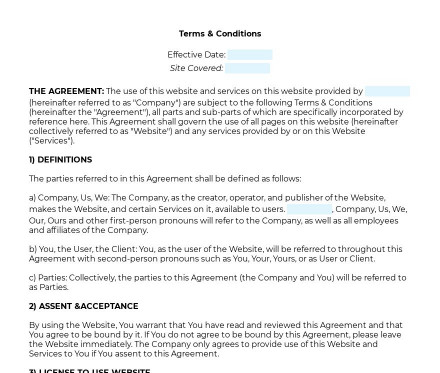Terms and Conditions for a Website Free
With this Terms & Conditions document, a website owner can inform users about how to use the site properly, as well as the obligations and responsibilities of each.


 Template Overview
Template Overview
With this Terms & Conditions document, a website owner can inform users about how to use the site properly, as well as the obligations and responsibilities of each.
One of the principal purposes of a Terms & Conditions document is to describe what will happen in a variety of different possible situations, including if the user breaks the rules and must have his/her account terminated. The Terms & Conditions document on any website creates a legally binding set of rules for the user.
This document differs from the Privacy Policy. Though a Terms & Conditions document may consist of information about the website owner's privacy practices, a Privacy Policy is a much more detailed document, comprehensively covering each aspect of user privacy.
You fill out a form. The document is created before your eyes as you respond to the questions.
At the end, you receive it in Word and PDF formats. You can modify it and reuse it.
 How to use this template
How to use this template
In the document, the website owner can outline the responsibilities for a user to a website, such as what the user can and cannot do and what happens in case of a dispute.
Within this document, the operator can choose several different models for what the website does, such as whether it sells products or services, gives professional advice, or lets other users post content like pictures, video, or status updates. It also addresses what happens if the user does anything to harm the website, like violating the intellectual property rights of the owner/operator.
A completed document should be posted online. Ideally, that page will be linked to from the homepage under the phrase "Terms & Conditions."
 Applicable law
Applicable law
No laws regulate what must be put into the Terms & Conditions for a website: although U.S. Common Law and the advertising and privacy laws of the Federal Trade Commission cover website disclosures.
Ready to build your document from this template?



 Please wait
Please wait